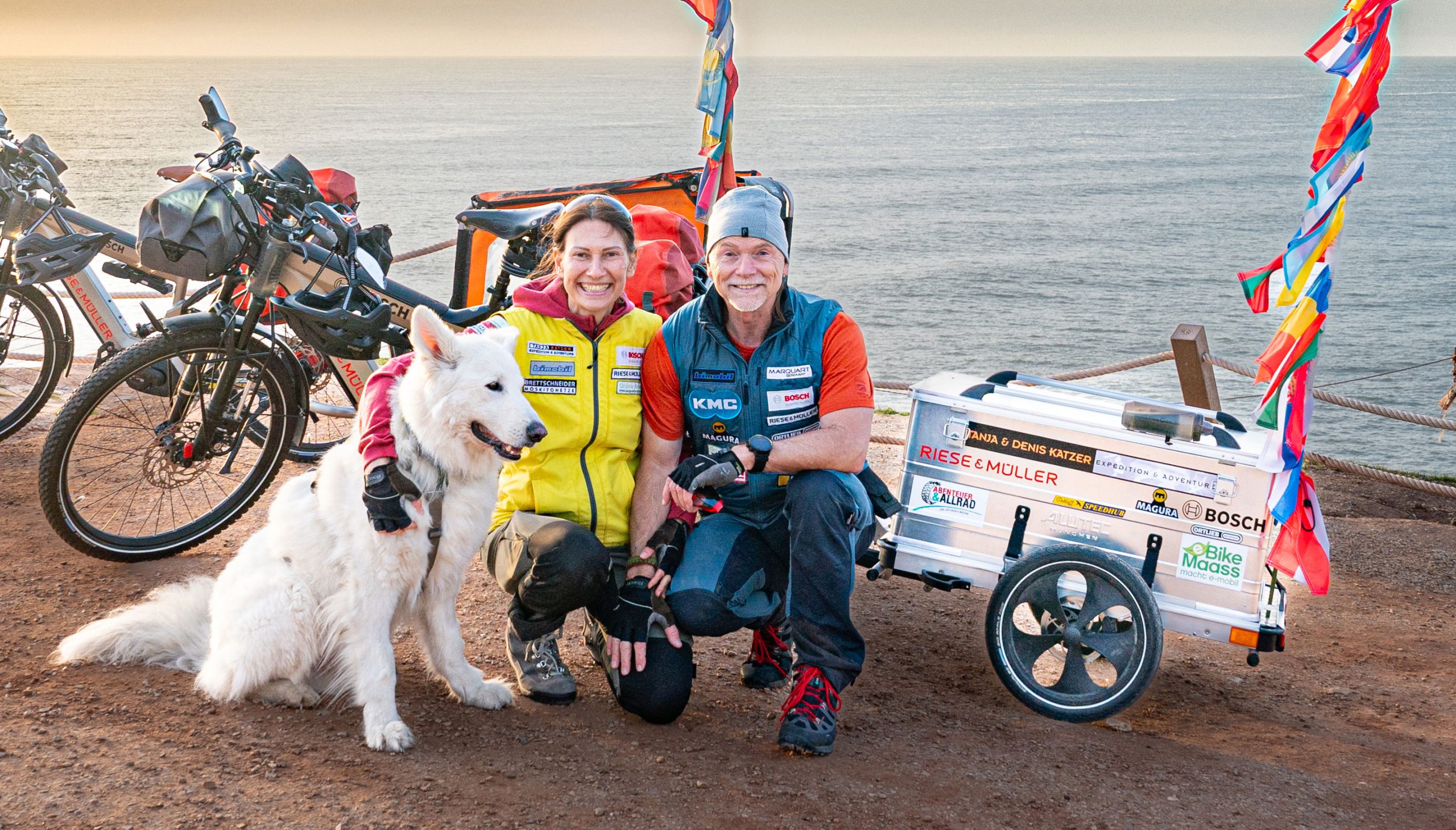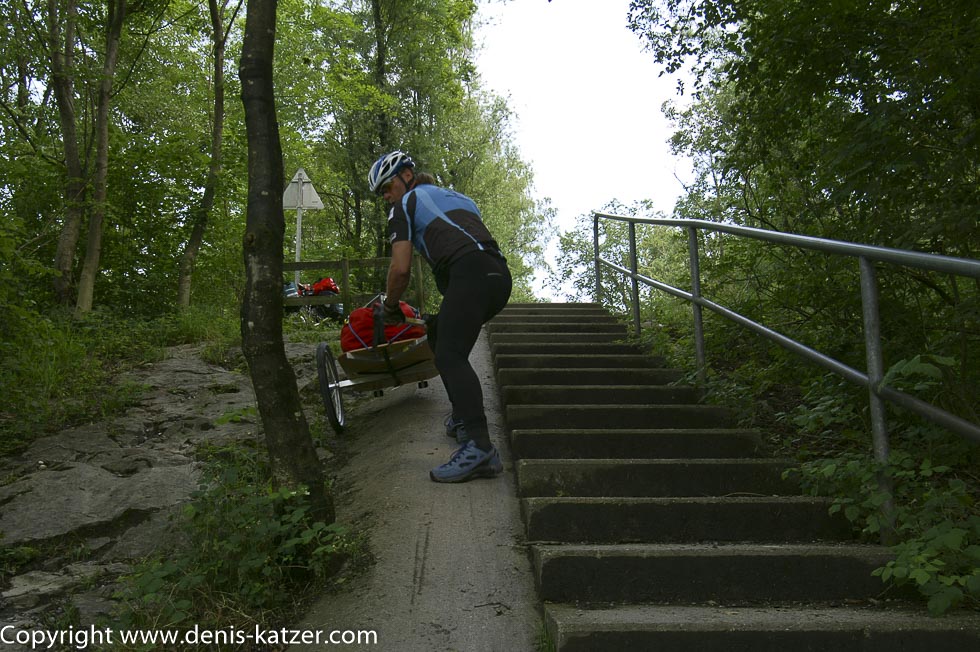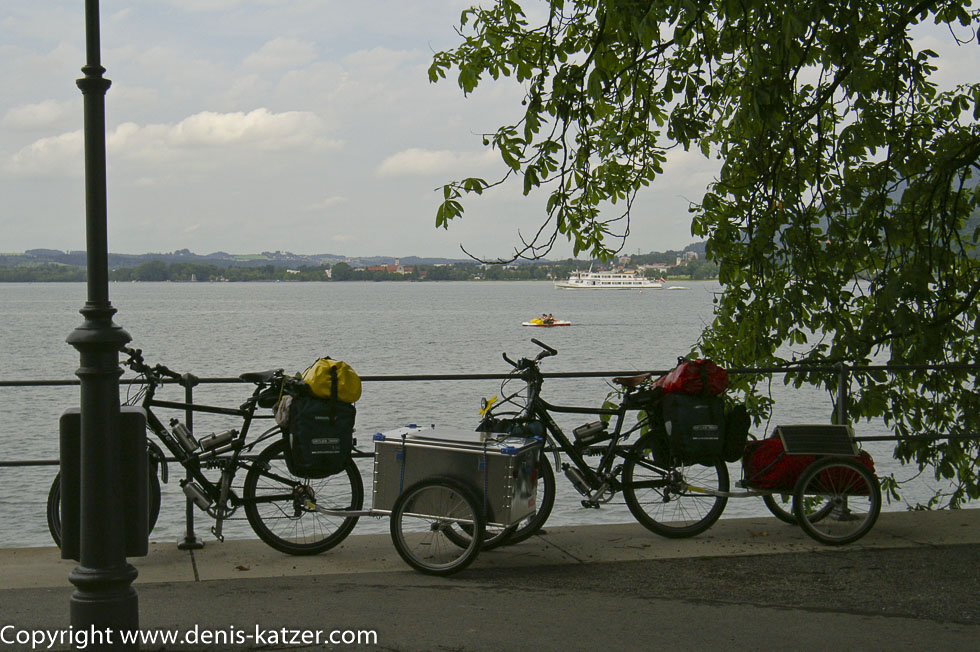
Do they even know where Burma is?
N 47°29'391'' E 009°33'907''
Day: 2
Sunrise:
05:50 h
Sunset:
9:06 pm
As the crow flies:
11 Km
Daily kilometers:
32 Km
Total kilometers:
87 Km
Soil condition:
Asphalt, gravel
Temperature – Day (maximum):
30 °C
Temperature – day (minimum):
25 °C
Temperature – Night:
20 °C
Latitude:
47°29’391”
Longitude:
009°33’907”
Maximum height:
400 m above sea level
Time of departure:
12.00 p.m.
Arrival time:
19.00 hrs
Average speed:
11.50 Km/h



In the early morning, the rain is still playing its drum solo on our tent. Slugs crawl around on the inner tent, the Ortlieb bags and our shoes. They leave a soggy streak and seem to feel very comfortable in the humidity. “My God, this is getting off to a good start,” Tanja’s sleepy voice cuts through the staccato of the rain. “What the hell, if it keeps pouring like this, I won’t get 10 horses out of here,” I reply and turn my body onto its side, yawning. It stops raining at 10:00 am. Dark clouds move over our heads in ghostly shapes. “We should keep driving,” Tanja suggests. Two hours later, we have stowed all our belongings on the bikes and trailers. We still haven’t found the optimal luggage distribution and are losing time as a result. But it won’t be long before we know in our sleep which item of equipment is in which bag.
Our bikes purr along the beautiful cycle path at around 10 to 15 kilometers per hour. Although God knows it’s not fast, we have to make a real effort. “Do you already have muscle cadres?” I ask Tanja. “Of course. I think we should have trained a bit more beforehand,” she replies, panting. “It’s a mystery to me how we can get up a hill with this monster luggage,” I reply and concentrate on the oncoming traffic. Every few minutes, one of the many cyclists comes towards us. We are amazed at the amount of bicycle traffic here.
Lake Constance is not actually on our route to Burma. But as we were in Friedrichshafen anyway for the press conferences, I thought it would be a good idea to take our trip slowly and start with this well-known cycle route around the Swabian Sea as a so-called training stage. Of course a joke for any die-hard cyclist, but for us newcomers, especially with the heavily loaded trailers, a sensible thing. We have just crossed the invisible border into Austria when I notice a cozy restaurant. “We’ll stop off there,” I say and don’t even need to ask Tanja what she thinks about taking a break after just five kilometers. “Take it slow,” some professional cyclists advised us, and I think that’s a damn good idea. We enjoy a Wiener schnitzel, salad followed by a nut cake and cappuccino. We leaned our roadtrains against a railing that borders directly on the shore of the lake.
Time and again, tourists and other cyclists stop to look at the heavily laden vehicles. “What do you do with the solar paddles on your trailers? Do you run a motor with them?” asks one of them. “Oh, you need these things to operate your satellite phone. You must be on the road for a while?” “Yes, we’re going to Burma,” I reply with a smile, causing the older gentleman to wince. “Like Burma?” he replies. “Well Burma,” I reply. “Do you mean Burma, somewhere in Asia?” “Yes.” “Do you even know where that is?” “Sure, that way, roughly south-east,” I reply with a laugh and point across the lake. “Well, they’ve got their work cut out for them,” he says with an astonished look on his face and wishes us good luck. As soon as we finish talking, another asks: “What are you doing with those solar paddles? Are you using them to power a cool box for your beer?” “No, it’s for our computer and the satellite phone.” “Satellite phone? What do you need a satellite phone for on Lake Constance?” “We’re cycling to Burma.” “To Burma! Which Burma?” “Well, Burma, just behind China.” The Lord looks at us with widened eyes and thinks he is being deceived by us. Shaking his head, he walks on. Before we get on our bikes, people are already standing around us again. “You’re not going to use the solar to boil your water, are you?” “No, no, we use it to charge our batteries for the cameras and the satellite phone”. “Oh, so you must be on a longer trip then?” “Yes, we’re going to Burma.” “By bike?” “Bicycle, horse and elephant,” we reply and explain our travel plan. In the meantime, more tourists gather and listen to our stories. It takes a while before we finally continue our cycle tour and say goodbye to the listeners.
We follow the cycle path. We leave the town of Bregenz behind us and are constantly overtaken by cyclists. “What are you doing with the solar paddles?” we hear the repetitive questions, to which we try to answer truthfully. The reactions are often similar, which is why we are already thinking about hiding the solar paddles when crossing national borders, especially into Ukraine, Russia, Mongolia and China. We don’t have to make the officials rummage around in our luggage at all costs.
In the afternoon, the cycle path ends at a steep flight of steps. “I think we’ve managed to get ourselves too far gone,” I say, shaking my head. Next to the stairs, coarse rocks protrude from the wet earth. I wonder whether it would be better to turn back and look for the right cycle path or to take on this little challenge as training for the unpaved Russian roads that are sure to come. I immediately uncouple the trailers from the bikes and am surprised at how much their weight pushes down the steep slope. It takes a lot of effort to keep her from falling down. I actually need Tanja’s helping hands, but she tries to capture our first obstacle on film. “I think the movie camera is broken. The colors look quite strange,” she says, handing me the camera. In fact, I realize that we’ve only covered 40 km and our film camera has already gone. “Hm, my mother should send the spare camera to the Bodenmüllers. We can stop by there on the way back,” I grumble to myself and put the now useless thing in my bag.
As soon as we’re ready to go again, a walker asks us what we’re doing down there. “It’s a footpath only. You won’t get far on your bikes. It’s best to turn back up there,” she advises us.
An hour later, we cross a bridge over the Alt Rhein river and find ourselves in Switzerland. We cycle along an unpaved path through a dark forest directly along the steep embankment of the Old Rhine. I often turn to the back to see where Tanja is. It has become slower and slower over the course of the day. I often have to wait every kilometer to see where she is. Obviously for its own weight of approx. 56 kg. the load on their trailer is far too heavy. Again, I turn backwards on my bike and when I look ahead, I wrench my handlebars. “Huuuaaahhh!” I exclaim as I juggle my heavily laden bike just a few centimeters past the precipice of the embankment. About five meters further down, the flood-saturated river flows past at an alarming speed. It’s too late to get off. Rowing, I try to regain my balance. Another centimeter to the right and the whole thing, including me, rushes into the gurgling river. I myself would certainly have no problem getting out of there with my skin intact, provided I didn’t get stuck on one of the tree stumps down there. But the bike with trailer and equipment would disappear in the floods never to be seen again. At the very last second, I manage to get the Roadtrain onto the safe route. “Phew,” I gasp in relief and stop for a moment. My heart is racing with excitement. I almost sank all our equipment in the Old Rhine. That would have been the end of our journey. And this here on a well-developed cycle path on Lake Constance. My God, how embarrassing. I can just imagine the mocking headline in a newspaper: “The cycling adventure planned for five years ends on the second day. Or: “For some unknown reason, Denis Katzer sank with his bike in the Old Rhine.”

